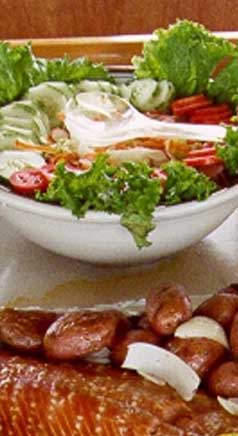


![]()
HOME > NOURISHING NEWS
May 2025
Food Choices May Help Improve Sleep?
Getting a good night’s sleep is vital for overall health and wellness. It may reduce the risk of chronic diseases, keep the brain healthy, and boost the immune system. Sleep is affected by many things, including lifestyle, underlying medical issues, and nutrition. Here are some food choices that may help improve your sleep, especially if you are sleep deprived.
The Role of Melatonin
Melatonin is a hormone that plays a role in regulating sleep cycles. It is produced in the body in response to darkness, often referred to as the “hormone of darkness.” Melatonin can be boosted by eating foods that are either rich in this hormone or enhance the production of it naturally. Including melatonin-rich foods along with a healthy eating pattern and active lifestyle may reduce restless nights.
Melatonin-Rich Foods
- Fish – Salmon, tuna and trout are good sources of melatonin. These fish are also rich in omega-3 fatty acids, which have been linked to better sleep quality. Try to have fish at least twice a week.
- Rice - Red, purple and black rice contain melatonin; however, they can also increase blood sugar levels rapidly. Include rice in moderation as part of a balanced meal that contains protein, vegetables and a healthy fat.
- Cherries – Tart cherries are a natural food source of melatonin. Have some in the evening to help boost melatonin levels. If you are insulin resistant or have diabetes they may increase blood sugar.
- Nighttime Milk – A warm glass of milk before bedtime is a natural remedy for better sleep. It contains tryptophan, that can enhance melatonin production. The warming of milk can help to relax and unwind. If you are lactose intolerant try lactose-free milk.
- Nuts – Almonds, walnuts and peanuts contain melatonin and also the mineral magnesium. This mineral has been shown to improve sleep quality, promoting feelings of calmness. Include nuts 2 hours before bedtime to benefit sleep. If you are trying to lose weight, nuts are calorically dense, so be mindful of portions.
Still Can’t Sleep?
Lifestyle habits can also impact sleep. Make small behavior changes such as:
- Limit caffeine, in the afternoon or evening.
- Make dinner your lightest meal.
- Limit spicy, sugary, high fat foods and alcohol close to bedtime.
- Stop eating two-hours prior to going to bed.
- If you take a nap, make it earlier in the day, and limit to 20-30 minutes.
- Be physically active, however, avoid exercising 4-hours before bedtime.
- Limit screen time, especially in bed.
- Develop a sleep routine by going to bed at the same time every night.
NOURISHING NEWS ARCHIVES

